An Introduction to Vera Rockline
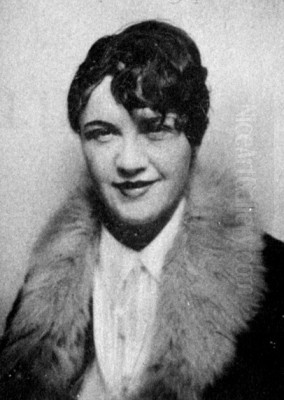
Vera Rockline, born Vera Nikolaevna Shlezinger in Moscow in 1896, stands as a compelling yet often overlooked figure in early 20th-century European art. A painter of Russian origin who became an integral part of the vibrant Parisian art scene, her life and career trace a fascinating path from the experimental ferment of the Russian avant-garde to the expressive figuration of the École de Paris. Known primarily for her sensual nudes, insightful portraits, and evocative landscapes, Rockline forged a distinct artistic identity, blending diverse influences into a unique visual language. Despite achieving considerable success during her lifetime, particularly in the 1920s and early 1930s, her premature death in 1934 led to a period of relative obscurity. Recent decades, however, have witnessed a resurgence of interest in her work, recognizing her contribution as a talented female artist navigating the complex currents of modernism.
Early Life and Artistic Formation in Russia
Born into a family with mixed Russian and French heritage – her father Russian, her mother French – Vera Rockline's early life unfolded against the backdrop of Moscow's dynamic cultural environment. This dual background perhaps prefigured her later artistic journey between these two major European cultures. She embarked on her artistic training in Moscow, a city buzzing with radical artistic ideas and movements in the years leading up to and following the Russian Revolution. This initial immersion in a milieu characterized by intense experimentation and a break from academic tradition would prove foundational, even as her style evolved significantly later in her career. The specific details of her earliest education remain somewhat fragmented, but it is clear that she quickly demonstrated significant talent and commitment to painting.
Formative Influences: Mashkov and Exter
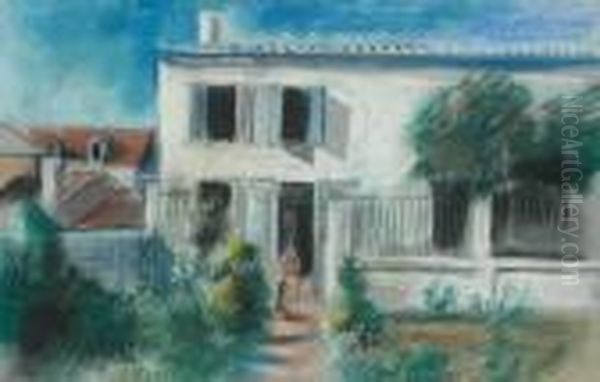
Rockline's formal artistic education included periods studying under two prominent figures of the Russian avant-garde, whose distinct approaches likely contributed to the breadth of her later work. In Moscow, she trained in the studio of Ilya Mashkov. Mashkov was a key member of the Jack of Diamonds (Bubnovy Valet) group, known for their bold colours, simplified forms, and influences drawn from Russian folk art, sign painting, Fauvism, and Cézannism. Artists like Pyotr Konchalovsky and Aristarkh Lentulov were also associated with this movement. Mashkov's emphasis on strong composition and vibrant, almost tactile representation of objects and figures may have instilled in Rockline a lasting appreciation for material presence in painting. She was reportedly considered one of his most gifted pupils.
Later, possibly in Kyiv, Rockline studied with Alexandra Exter. Exter was a central figure in the Cubo-Futurist movement and later explored Constructivism. She was deeply connected to artistic developments in both Russia and Western Europe, particularly Paris, and was renowned for her dynamic compositions, non-objective art, and innovative work in theatre and costume design. Studying with Exter would have exposed Rockline to the principles of Cubism, Futurism's dynamism, and a sophisticated understanding of colour theory. The influence of artists like Pablo Picasso and Georges Braque, filtered through Exter's unique interpretation, likely informed Rockline's early engagement with modernist fragmentation and structure, even if her mature style moved away from pure abstraction.
Embracing Paris: A New Artistic Chapter
Around 1919 or 1920, following the upheaval of the Russian Revolution and Civil War, Vera Rockline made the pivotal decision to leave her homeland and move to France. This emigration was part of a larger wave of Russian artists and intellectuals seeking new opportunities or refuge in Western Europe. Paris, still the undisputed capital of the art world, was a natural destination. She settled there, initially living near the artistic hub of Montmartre with her husband (whose identity remains largely undocumented). This move marked a definitive shift in her life and artistic trajectory, immersing her in a new cultural and creative environment that would profoundly shape her subsequent work. The transition allowed her to synthesize her Russian avant-garde training with the prevailing currents of Parisian modernism.
Integration into the École de Paris

Upon arriving in Paris, Rockline quickly integrated into the city's bustling art scene. She became associated with the École de Paris (School of Paris), a term used not to describe a formal institution or unified style, but rather the diverse community of foreign artists who flocked to the city, particularly Montparnasse, during the first half of the 20th century. This vibrant milieu included figures from across Europe and beyond, such as Amedeo Modigliani from Italy, Chaïm Soutine and Marc Chagall from the Russian Empire (now Belarus and Russia respectively), Moïse Kisling from Poland, and Tsuguharu Foujita from Japan. Rockline found a place within this international cohort, contributing her unique perspective shaped by her Russian roots and training.
Her talent gained recognition through regular participation in the major Parisian Salons. These large, juried exhibitions were crucial venues for artists to showcase their work, attract critical attention, and secure patronage. Rockline exhibited frequently at the Salon des Indépendants, the Salon d'Automne, and later the Salon des Tuileries, starting as early as 1921. Her consistent presence in these prestigious shows indicates her growing reputation and acceptance within the Parisian art establishment. It was through these exhibitions that her work, particularly her increasingly characteristic nudes and portraits, reached a wider audience.
Artistic Style: From Avant-Garde to Sensual Realism
Vera Rockline's artistic style underwent a significant evolution throughout her career. While her early work, influenced by Mashkov and Exter, likely reflected the concerns of the Russian avant-garde – potentially incorporating elements of Neo-Primitivism, Cubism, or Fauvism – her move to Paris precipitated a shift towards a more figurative and expressive approach. Although sometimes described as having early "Surrealist tendencies," her mature style aligns more closely with the broader currents of Post-Impressionism and Expressionism within the context of the École de Paris.
She developed a distinctive manner characterized by a rich, often warm palette, fluid brushwork, and a profound sensitivity to the human form. While retaining a modern sensibility in composition and the simplification of forms, she moved away from radical abstraction. Instead, she sought a balance between modernist structure and a more traditional, sensual rendering of her subjects. Influences from masters like Peter Paul Rubens, with his celebration of flesh and dynamic forms, and Auguste Renoir, known for his luminous depictions of figures and light, are often cited in relation to her work, particularly her nudes. Echoes of Paul Gauguin's bold colour and simplified shapes might also be discerned.
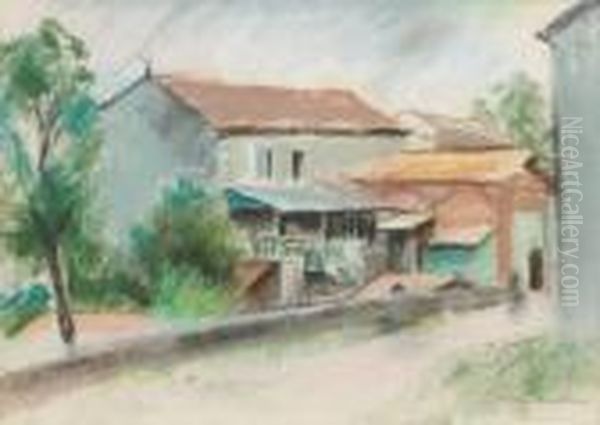
Her style was praised by contemporary critics for its unique blend of strength and tenderness. The French critic Raymond Escholier reportedly described her nudes as a "sensual symphony," highlighting the evocative, almost musical quality of her depictions of the human body. This suggests an art that appealed not just to the eye but also engaged the senses on a deeper level, focusing on texture, warmth, and vitality. Her work successfully navigated a path between academic tradition and avant-garde experimentation, resulting in paintings that felt both contemporary and timeless.
Thematic Focus: Nudes and Portraiture
The female nude became a central and defining theme in Vera Rockline's oeuvre, particularly during her Parisian years. She approached the subject with a distinctive blend of intimacy, realism, and expressive power. Her nudes often possess a palpable sense of presence and physicality, rendered with warm flesh tones and soft, yet confident, brushwork. Unlike the cool, idealized nudes of academic tradition or the fragmented forms of early Cubism, Rockline's figures feel grounded and alive. They convey a sense of vulnerability and strength simultaneously, often depicted in relaxed, natural poses within intimate interior settings. Her handling of light and shadow contributes to the modelling of form, emphasizing the curves and weight of the body. Comparisons could be drawn to the nudes of fellow École de Paris artists like Modigliani or Jules Pascin, yet Rockline maintained her own unique sensibility, often imbued with a greater warmth and less overt stylization.
Portraiture was another significant aspect of her work. Her Man in a Top Hat: Portrait of Pierre Fronaudi (1926) is a notable example, capturing the elegance and perhaps the underlying melancholy of the sitter, characteristic of the "Roaring Twenties" era. Her portraits, like her nudes, often reveal a psychological insight and a focus on capturing the individual character of the subject through pose, expression, and the handling of paint. She painted individuals from her circle, contributing to the rich tapestry of portraiture that documented the artistic and social milieu of Paris at the time. Artists like Kees van Dongen, also active in Paris and known for his vibrant portraits of society figures, worked in a related field, though Rockline's style generally remained more subdued and introspective.
Exploring Landscapes and Still Lifes
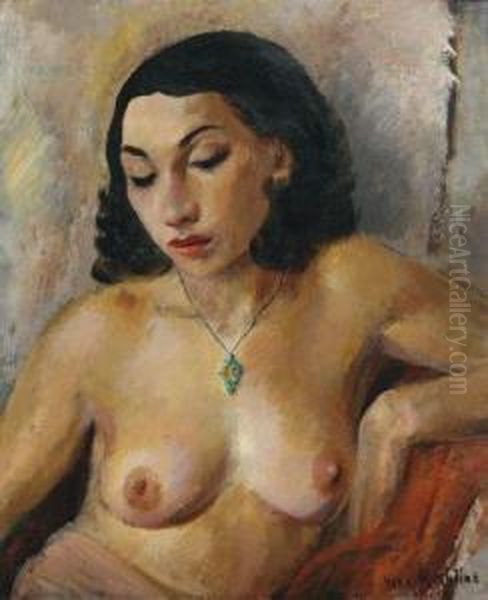
While best known for her figure paintings, Vera Rockline also engaged with other genres, including landscape and still life. Examples such as Vue du jardin (View of the Garden), Les bords de Seine (Banks of the Seine), and Rue de village (Village Street) demonstrate her application of her stylistic approach to the natural and built environment. These works often showcase her sensitivity to colour and atmosphere, possibly drawing on Impressionist and Post-Impressionist traditions, perhaps recalling the light-filled canvases of Claude Monet or the structural landscapes of Paul Cézanne. Her use of pastels in some works allowed for a different texture and luminosity compared to her oils.
Her still lifes, though perhaps less numerous or well-documented, likely provided another avenue for exploring form, colour, and composition, themes central to her artistic practice. Following the lineage of artists from Jean-Baptiste-Siméon Chardin to Cézanne and the Fauves like Henri Matisse and André Derain, still life offered a space for formal experimentation and the exploration of the painterly qualities of everyday objects. For Rockline, these genres likely complemented her work with the human figure, allowing her to explore different facets of visual reality through her evolving style.
Key Works and Critical Acclaim
Throughout the 1920s and early 1930s, Vera Rockline achieved significant recognition in the competitive Parisian art world. Her regular participation in the major Salons brought her work to public and critical attention. The aforementioned portrait, Man in a Top Hat: Portrait of Pierre Fronaudi, stands out as a representative work capturing the spirit of the era and her skill in portraiture. Her numerous nudes, though often untitled or simply titled Nu (Nude), collectively form the core of her recognized output and were highly praised for their sensuality and painterly quality.
Her talent attracted admiration from influential figures beyond the art criticism sphere. Notably, the celebrated fashion designer Paul Poiret, known for his revolutionary designs and patronage of the arts (he famously collaborated with artists like Raoul Dufy), was an admirer of Rockline's work. His support likely provided valuable encouragement and potentially opened doors within Parisian society. There are also accounts suggesting that Pablo Picasso, a towering figure in modern art, recognized her talent and may have recommended her to a gallery, although concrete documentation for this specific event can be elusive. The acquisition of her works by French state institutions, eventually finding homes in museums like the Musée d'Orsay in Paris, the Musée Rodin (which holds works from the former Musée du Luxembourg collection), and the Musée de Valence, further attests to the official recognition she received during her lifetime.
Connections within the Parisian Milieu
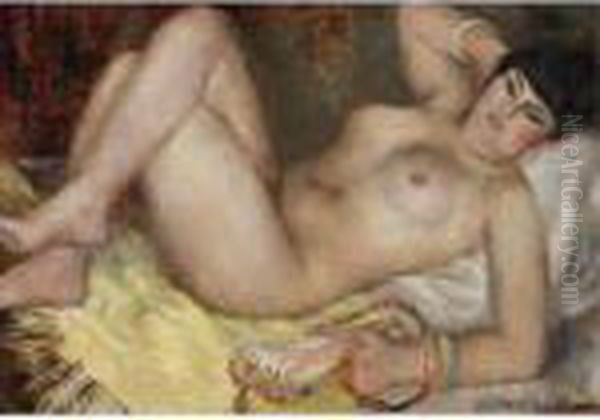
Vera Rockline's life in Paris placed her within a rich network of artists, writers, and intellectuals. As part of the École de Paris, she would have inevitably crossed paths with many of the leading creative figures of the day. Beyond the painters already mentioned (Modigliani, Soutine, Chagall, Kisling, Foujita, Pascin, Van Dongen), her contemporaries included sculptors like Jacques Lipchitz and Ossip Zadkine, and fellow Russian émigré artists such as Sonia Delaunay, who, with her husband Robert Delaunay, pioneered Orphism.
Her connections extended into the literary world as well. She is known to have been acquainted with the French poet and playwright Charles Vildrac. The interaction between visual artists and writers was a hallmark of the Parisian scene, fostered in the cafes, studios, and galleries of Montparnasse and Montmartre. Figures like the poet and art critic Guillaume Apollinaire had played a crucial role in championing Cubism and other avant-garde movements slightly earlier, setting a precedent for the close relationship between artistic and literary innovation that Rockline would have experienced. These connections provided not only personal support but also intellectual stimulation, contributing to the fertile environment in which her art developed.
Personal Life and Tragic End
Compared to the relative visibility of her artistic career, details about Vera Rockline's personal life remain somewhat scarce and occasionally enigmatic. She arrived in Paris with a husband, but his identity and their life together are not well documented. Sources mention a period where she briefly left her family, only to return to her mother's home, suggesting potential personal difficulties or complexities in her relationships. Later, during the 1920s, she reportedly lived with a second partner, described as a "mysterious" relationship and possibly not formalized by marriage. This lack of concrete detail contributes to an aura of reserve around her private life.
Despite the professional success she was enjoying, Rockline's life was cut tragically short. In 1934, at the height of her artistic powers and recognition, she died by suicide in Paris. She was only 38 years old. The reasons behind this desperate act remain unknown, leaving a poignant silence surrounding the end of a promising career. Her death occurred just as she was solidifying her position as a significant artist within the Parisian scene, making her loss particularly lamentable.
Legacy and Rediscovery
Following her untimely death, Vera Rockline's work gradually faded from mainstream art historical narratives for several decades. This was not uncommon for many artists, particularly women, whose careers were interrupted or overshadowed by larger events and dominant figures. However, beginning in the late 20th and early 21st centuries, renewed scholarly and market interest has brought her art back into focus. Exhibitions and publications have shed new light on her contributions, reassessing her place within the École de Paris and the broader context of 20th-century figurative painting.
Her legacy lies in her unique synthesis of diverse artistic traditions. She successfully navigated the transition from the Russian avant-garde to the more sensual, figurative modes prevalent in Paris, creating a body of work characterized by technical skill, emotional depth, and a distinctive focus on the human form. As a female artist achieving recognition in a male-dominated field, her career holds particular significance. Her rediscovery allows for a richer, more nuanced understanding of the École de Paris, highlighting the contributions of artists who, like Rockline, forged individual paths amidst the era's complex artistic currents. Her paintings continue to resonate with viewers today through their intimate portrayal of humanity and their sophisticated handling of colour and form.
Enduring Significance
Vera Rockline's artistic journey from Moscow to Paris encapsulates a key chapter in the history of modern European art – the cross-cultural exchanges and stylistic fusions that characterized the early 20th century. Trained by leading figures of the Russian avant-garde yet finding her mature voice within the expressive figuration of the School of Paris, she created a body of work notable for its sensual beauty, psychological insight, and painterly finesse. While her life ended tragically and her work endured a period of neglect, her rediscovery affirms her status as a talented and significant artist. Her paintings, particularly her evocative nudes and portraits, stand as a testament to her unique vision and secure her place as a compelling voice within the diverse chorus of Parisian modernism.